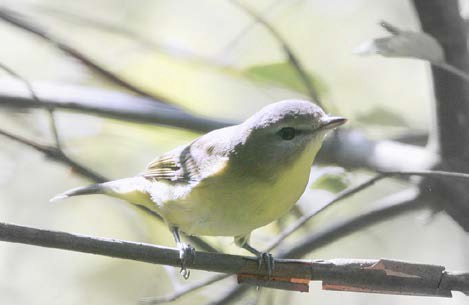
I selected the mystery species in this issue to encourage readers to visit the Bird Observer website where the mystery photograph can be viewed in color—which should make determining the bird’s identity significantly easier than when viewing it in black and white. Nonetheless, the discerning reader should be able to identify this bird even when not seen in color.
Characteristics to notice about the mystery bird are its thin legs (a clue that the bird is quite a small passerine), relatively thick but pointed bill, overall chubby appearance, and the absence of ventral streaks, wing bars, bold markings on the head, or any other striking markings. In essence, the bird appears quite featureless in overall coloration in the black and white photograph. Again, this is a reason to look at the image on the website where it can be viewed in color!
This caveat aside, close observation reveals features that should lead to a correct identification even with the black and white photograph. The shape and thickness of the bill are suggestive of a vireo and possibly also of a warbler, but the completely uniform coloration is a characteristic rare in most warbler species. There are practically no warbler species that exhibit such a featureless plumage, except a Tennessee or an Orange-crowned warbler. However, both of these species have much thinner and more pointed bills than the mystery bird. Additionally, a Tennessee Warbler possesses a pale or whitish supercilium, and neither species shows the obvious contrast seen between the breast and the face and neck area of the mystery species.
Notice the chesty or overall plump appearance of the mystery bird, another characteristic of vireos rather than warblers. The bird also shows a prominent dark area between the eye and the bill, which are the lores. With these differences in mind, the identification clincher in this picture becomes the dark lores. Combined with the chubby shape and otherwise featureless aspects of the mystery bird, the dark lores represent a hallmark field characteristic of a Philadelphia Vireo (Vireo philadelphicus). The Warbling Vireo (Vireo gilvus) is similar, but lacks this distinctive dark feathering between the eye and bill and—as can be noted on the website—has a yellowish wash on the breast.
The Philadelphia Vireo is an uncommon to rare late spring migrant in Massachusetts and an uncommon fall migrant in late August and early September, especially along the coast. The author photographed this Philadelphia Vireo on September 7, 2008, at Pochet Island, Orleans.